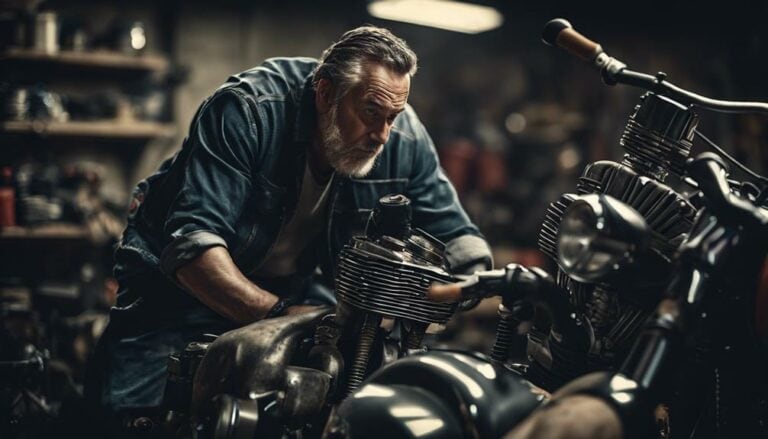If you find yourself facing issues with your Harley Davidson motorcycle, it's essential to tackle them efficiently. From mysterious engine noises to electrical conundrums, troubleshooting can be a daunting task.
However, with a methodical approach and a keen eye for detail, you can navigate these challenges with confidence. By understanding the intricacies of your bike and learning the art of diagnosis, you can unravel complex problems and get back on the road swiftly.
Stay tuned to discover practical tips and techniques that can help you troubleshoot your Harley Davidson motorcycle effectively.
Key Takeaways
- Identify spark plug issues by observing poor performance or noise.
- Troubleshoot electrical system for faulty ignition components.
- Address engine start problems by checking switches and battery.
- Resolve gear shifting concerns through clutch and transmission checks.
Identifying Spark Plug Problems
Are you experiencing poor performance or loud noise from your Harley-Davidson motorcycle? These symptoms could be indicative of faulty spark plugs. Spark plugs play a crucial role in the ignition process of your bike's engine.
If even one spark plug is faulty, it can lead to issues such as misfires, rough idling, decreased fuel efficiency, and even difficulty starting your motorcycle. To identify spark plug problems, inspect them for signs of wear, such as blackened or oily deposits, worn electrodes, or cracks on the insulator.
If you notice any of these issues, it's time to clean or replace your spark plugs. When replacing spark plugs, it's recommended to change all of them to ensure consistent performance. Replacement spark plugs are affordable and can be found at most auto stores.
Troubleshooting Electrical System
Experiencing issues with the electrical system of your Harley-Davidson motorcycle requires a thorough understanding of its basic components for effective troubleshooting. When encountering electrical problems, it's important to consider the following:
- Faulty Spark Plugs: Inspect the spark plugs for signs of wear or damage, as they play a crucial role in the ignition process.
- Electrical Issues: Check the battery, wiring, and charging system for any anomalies that could be causing electrical malfunctions.
- Faulty Ignition or Sensor: A faulty ignition system or sensor can lead to starting and running issues, requiring careful examination and potential replacement.
To effectively troubleshoot the electrical system of your Harley-Davidson, utilize tools and equipment to test different components. Referencing wiring diagrams and electrical schematics can aid in diagnosing complex problems accurately.
Always prioritize safety precautions to prevent accidents or further damage to your motorcycle while working on the electrical system.
Dealing With Engine Start Issues
If encountering difficulties starting your Harley-Davidson motorcycle, begin by thoroughly assessing the ignition switch position and ensuring the engine run switch is set to ON.
Check the battery terminals for tightness and signs of corrosion that may impede starting. Make sure the brake pedal is engaged when trying to start the engine, as some models require this safety feature. Verify the brake fluid level is adequate, as low levels can prevent the engine from starting.
Consulting the Service Manual for your specific model can provide valuable insights into troubleshooting the starting system. If the engine still fails to start, inspect the starter control circuit, relay, and solenoid for proper operation. Additionally, examine the fuel tank for an ample fuel supply and inspect the spark plugs for any fouling that could hinder ignition.
Addressing these potential issues systematically can help resolve engine start problems efficiently.
Resolving Gear Shifting Problems
Gear shifting problems on Harley-Davidson motorcycles often stem from issues related to the clutch, transmission, or shifter mechanism. When encountering gear shifting issues, consider the following:
- Check the Clutch Adjustment: Ensure the clutch is properly adjusted to allow for smooth gear changes.
- Inspect Transmission Fluid Levels: Low transmission fluid can lead to difficulties in shifting gears smoothly.
- Lubricate the Shifter Mechanism: Lack of lubrication can cause the shifter mechanism to function improperly, affecting gear changes.
To tackle gear shifting problems effectively, it's crucial to address these key areas. Pay attention to any signs such as difficulty shifting, grinding noises, or gears slipping, as these can indicate underlying issues with the clutch, transmission, or shifter mechanism.
Handling Brake System Malfunctions
When troubleshooting Harley-Davidson motorcycles, addressing brake system malfunctions is crucial for maintaining optimal safety and performance on the road. Common issues that can lead to brake problems include a low brake fluid reservoir, worn brake pads, air bubbles in the brake system, and worn or damaged master cylinder/caliper piston seals.
To diagnose these issues, start by checking the brake fluid level in the reservoir and inspecting the brake pads for wear. If the brake pads are worn, replacing them with new ones can help restore braking efficiency.
Air bubbles in the brake system can be bled out to improve braking performance. Inspect the master cylinder and caliper piston seals for any signs of wear or damage, as these can also cause brake malfunctions. Contaminated brake pads should be cleaned or replaced to ensure proper braking.
Additionally, check for any warping or wear on the brake discs, as this can affect the motorcycle's stopping power. Going back to these common issues and addressing them proactively can help you diagnose and resolve brake system malfunctions effectively, keeping you safe on your Harley-Davidson motorcycle.
Conclusion
In conclusion, troubleshooting Harley Davidson motorcycles requires attention to several key areas:
- Spark plug problems
- Electrical system issues
- Engine start problems
- Gear shifting challenges
- Brake system malfunctions
Remember to address these common issues promptly to ensure optimal performance and safety on the road.
Just like a well-oiled machine, your Harley Davidson needs regular maintenance and care to keep running smoothly and efficiently. So, stay vigilant and tackle any problems that arise with confidence and expertise.

